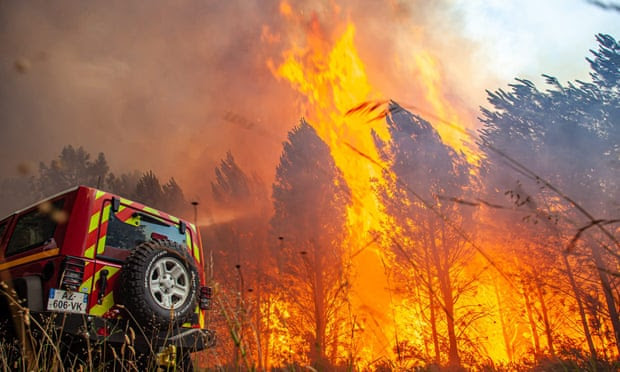Very important fire ravage since Friday, July 22, the Californian forest continued to spread Sunday, July 24, causing the evacuation of thousands of people, in a context of strong peaks of heat affecting tens of millions of Americans all the United States.
The “Oak Fire” fire is spreading in Mariposa County, near Yosemite National Park and its famous giant redwoods.
It “has grown significantly in the northern portion, moving further into the Sierra National Forest,” according to a bulletin Sunday from the California Department of Forestry and Fire Protection.
Fueled by “extreme drought,” winds and rising temperatures, the fire, fought by some 2,000 firefighters, has burned at least 5,500 hectares of forest, destroyed ten properties, damaged five others and is threatening more than 2,500, a spokeswoman for the department told AFP.
More than 6,000 people, mostly living in small communities at higher elevations, had to evacuate on Saturday, according to another California fire department spokesman, quoted by the Los Angeles Times newspaper.
“It was scary when we left because we were getting ash, and we had a vision of this (smoke) cloud. It looked like it was over our house and coming toward us very quickly,” Lynda Reynolds-Brown, a woman who had to leave her home, testified on local television station KCRA 3.
“We were starting to get our stuff together. I went back up the hill to look, and I thought +Oh my God+, it (the fire) was coming fast,” added her husband, Aubrey Brown, near a Mariposa school, that turned into an emergency shelter.
The park of Yosemite, one of the most famous in the world, had known mid-July a fire whose flames had threatened its giant sequoias.
The American West has experienced forest fires of exceptional size and intensity in recent years, with a clear lengthening of the fire season, a phenomenon that scientists attribute to climate change.
“Oak Fire” is one of the most dramatic manifestations of the heat wave that hit the U.S. this weekend in the Northwest, Central and Northeast. According to a map from the National Weather Service (NWS), a very large part of the country, including California, the entire South, and then much of the East Coast, experienced temperatures of 37 °C to 43 °C.
A scorching heat that should ease somewhat on Monday, July 25: it will “continue to rage in the center and northeast this (Sunday) evening, July 24, before the upper-level trough over Canada descends into the region to moderate temperatures a bit tomorrow” (Monday), according to the NWS forecast.
But not all areas will benefit: temperatures of 37 °C or higher are forecast for the next few days in parts of eastern Kansas and Oklahoma, to southern Missouri and northern Arkansas.
Even the usually cool Pacific Northwest will not escape the heat, with high temperatures “expected to rise steadily over the next few days and could break records,” the NWS adds.
“Scientists have been predicting these extraordinary and catastrophic events for decades now,” reaffirmed former U.S. Vice President Al Gore, who won a Nobel Peace Prize in 2007 for his commitment to the climate, on ABC News on Sunday.
“Today, they are saying that if we don’t stop using our atmosphere as a garbage can and if we don’t stop these (greenhouse gas) emissions that trap heat, things will get worse. More people will be killed, and the survival of our civilization is at stake,” he added.



Comment here